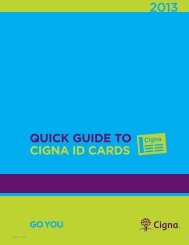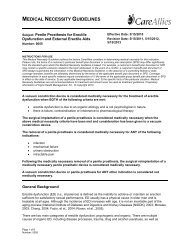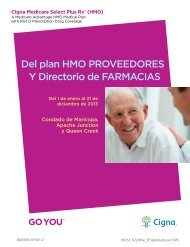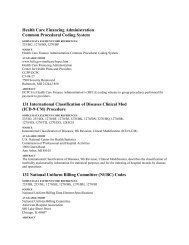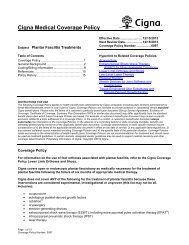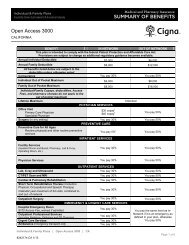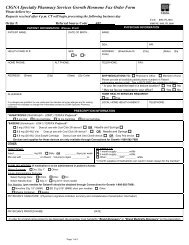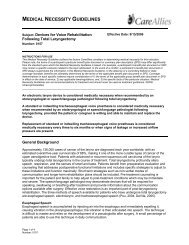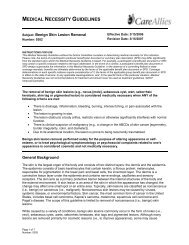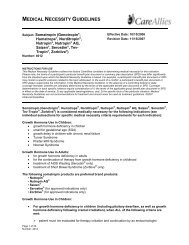Electrical Stimulators - Cigna
Electrical Stimulators - Cigna
Electrical Stimulators - Cigna
You also want an ePaper? Increase the reach of your titles
YUMPU automatically turns print PDFs into web optimized ePapers that Google loves.
intolerance. The limited number of studies, heterogeneous patient populations and variability in NMES<br />
methodology prohibited the use of meta-analysis. Although some of the studies reported significant<br />
improvements with NMES compared to no exercise or usual care, outcomes, including adverse events, were<br />
conflicting. Additional studies are indicated to provide sufficient evidence to establish the clinical utility of NMES<br />
in this patient population.<br />
Knee Surgery: Kim et al. (2010) conducted a systematic review of randomized controlled trials (n=8) to assess<br />
the effectiveness of NMES on “quadriceps strength, functional performance, and self-reported function after<br />
anterior cruciate ligament reconstruction.” Control interventions included: therapeutic exercises, EMG<br />
biofeedback, TENS plus exercises, and weight-bearing exercises. Quadriceps strength outcomes varied with<br />
some studies favoring NMES while others reported equivocal results or favored control interventions. One study<br />
each reported functional testing (n=20) and patient self-reported outcomes (n=43). Although some studies<br />
reported improvement following NMES, this analysis was limited by the use of various NMES regimens (e.g.,<br />
treatment duration ranged from three to 11 weeks, number of sessions ranged from 12–105) and overall, only<br />
one follow-up visit occurred immediately following completion of treatment sessions. There is insufficient<br />
evidence to support clinical meaningful benefit of NMES on functional performance.<br />
In a systematic review of randomized controlled trials, Monaghan et al. (2010) assessed the effectiveness of<br />
NMES in strengthening quadriceps before and after total knee replacement. Two studies met inclusion criteria.<br />
NMES plus exercise resulted in better quadriceps muscle activation compared to exercise alone (n=39), but was<br />
not maintained at the 12-week follow-up. No significant differences were reported in either study for maximum<br />
voluntary isometric torque or endurance between the NMES group and the control group.<br />
In a 2008 systematic review of anterior cruciate ligament reconstruction (ACL) rehabilitation, Wright et al.<br />
reported that 14 randomized controlled trials had evaluated postoperative NMES following ACL reconstruction.<br />
Because of the variety of parameters in the studies; poor study quality; heterogeneous patient populations; and<br />
the lack of randomization, blinding and independent observers, the authors noted that it was difficult to make<br />
generalized conclusions regarding NMES, and it did not appear to be a requirement for successful ACL<br />
reconstruction rehabilitation.<br />
Stroke: In a randomized controlled trial (n=60), Hsu et al. (2010) compared high-NMES and low-NMES to a<br />
control group (standard rehabilitation) for the treatment of upper-extremity function in acute stroke patients. The<br />
low NMES group received 30 minutes of stimulation per day and the high-NMES group received 60 minutes per<br />
day, five times per week, for four weeks. All patients received standard rehabilitation. Compared to the control<br />
group, the NMES groups showed significant improvement in the Fugl-Meyer Motor Assessment (p=0.003) and<br />
Action Research Arm Test scales (p=0.016) at week four and week 12. There were no significant differences<br />
between low- and high-NMES stimulation. No significant differences between the groups were reported on the<br />
motor activity log. Limitations of the study include the small patient population, short-term follow-up, and 12<br />
patients lost to follow-up.<br />
Professional Societies/Organizations: The American Society of Anesthesiologists Task Force on Chronic<br />
Pain and the American Society of Regional Anesthesia and Pain Medicine practice guidelines (2011) stated that<br />
NMES may be used as part of a multimodal treatment of patients with painful peripheral nerve injuries<br />
unresponsive to other therapies.<br />
In the evaluation of the literature regarding electrical stimulation for the treatment of spasticity in multiple<br />
sclerosis, the Multiple Sclerosis Council for Clinical Practice Guidelines (2005) stated that “surface electrical<br />
stimulation may be of benefit in reducing spasticity in persons with MS, but there is currently no evidence to<br />
support this supposition at this time.”<br />
Transcutaneous <strong>Electrical</strong> Nerve Stimulation (TENS)<br />
Generally, persistent ongoing pain for three to six months or longer is considered chronic pain, though a clear<br />
and consistent definition of when pain becomes chronic has not been established. Consideration as to the<br />
underlying illness, pathophyisology and natural course of the condition may be factors in determining when an<br />
acute pain condition becomes chronic or when a chronic illness develops a component of chronic pain due to<br />
the underlying disorder. For instance, chronic pain has also been described as pain that continues a month or<br />
more beyond the usual recovery period for an injury or illness or that goes on for months or years due to a<br />
chronic underlying medical or orthopedic condition. Chronic pain suggests a course of illness that will require<br />
Page 4 of 41



